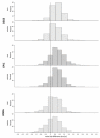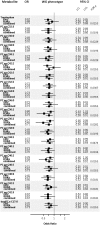Specific Metabolic Markers Are Associated with Future Waist-Gaining Phenotype in Women
- PMID: 27322650
- PMCID: PMC4920591
- DOI: 10.1371/journal.pone.0157733
Specific Metabolic Markers Are Associated with Future Waist-Gaining Phenotype in Women
Abstract
Objective: Our study aims to identify metabolic markers associated with either a gain in abdominal (measured by waist circumference) or peripheral (measured by hip circumference) body fat mass.
Methods: Data of 4 126 weight-gaining adults (18-75 years) from three population-based, prospective German cohort studies (EPIC, KORA, DEGS) were analysed regarding a waist-gaining (WG) or hip-gaining phenotype (HG). The phenotypes were obtained by calculating the differences of annual changes in waist minus hip circumference. The difference was displayed for all cohorts. The highest 10% of this difference were defined as WG whereas the lowest 10% were defined as HG. A total of 121 concordant metabolite measurements were conducted using Biocrates AbsoluteIDQ® kits in EPIC and KORA. Sex-specific associations with metabolite concentration as independent and phenotype as the dependent variable adjusted for confounders were calculated. The Benjamini-Hochberg method was used to correct for multiple testing.
Results: Across studies both sexes gained on average more waist than hip circumference. We could identify 12 metabolites as being associated with the WG (n = 8) or HG (n = 4) in men, but none were significant after correction for multiple testing; 45 metabolites were associated with the WG (n = 41) or HG (n = 4) in women. For WG, n = 21 metabolites remained significant after correction for multiple testing. Respective odds ratios (OR) ranged from 0.66 to 0.73 for tryptophan, the diacyl-phosphatidylcholines (PC) C32:3, C36:0, C38:0, C38:1, C42:2, C42:5, the acyl-alkyl-PCs C32:2, C34:0, C36:0, C36:1, C36:2, C38:0, C38:2, C40:1, C40:2, C40:5, C40:6, 42:2, C42:3 and lyso-PC C17:0.
Conclusion: Both weight-gaining men and women showed a clear tendency to gain more abdominal than peripheral fat. Gain of abdominal fat seems to be related to an initial metabolic state reflected by low concentrations of specific metabolites, at least in women. Thus, higher levels of specific PCs may play a protective role in gaining waist circumference.
Conflict of interest statement
Figures


Similar articles
-
Associations of anthropometric markers with serum metabolites using a targeted metabolomics approach: results of the EPIC-potsdam study.Nutr Diabetes. 2016 Jun 27;6(6):e215. doi: 10.1038/nutd.2016.23. Nutr Diabetes. 2016. PMID: 27348203 Free PMC article.
-
Association of Circulating Metabolites With Risk of Coronary Heart Disease in a European Population: Results From the Biomarkers for Cardiovascular Risk Assessment in Europe (BiomarCaRE) Consortium.JAMA Cardiol. 2019 Dec 1;4(12):1270-1279. doi: 10.1001/jamacardio.2019.4130. JAMA Cardiol. 2019. PMID: 31664431 Free PMC article.
-
Metabolic signatures of greater body size and their associations with risk of colorectal and endometrial cancers in the European Prospective Investigation into Cancer and Nutrition.BMC Med. 2021 Apr 30;19(1):101. doi: 10.1186/s12916-021-01970-1. BMC Med. 2021. PMID: 33926456 Free PMC article.
-
Long-term status and change of body fat distribution, and risk of colorectal cancer: a prospective cohort study.Int J Epidemiol. 2016 Jun;45(3):871-83. doi: 10.1093/ije/dyv177. Epub 2015 Sep 24. Int J Epidemiol. 2016. PMID: 26403814 Free PMC article.
-
Distribution of body fat and risk of coronary heart disease in men and women.Curr Opin Cardiol. 2008 Nov;23(6):591-8. doi: 10.1097/HCO.0b013e328313133a. Curr Opin Cardiol. 2008. PMID: 18830075 Review.
Cited by
-
Serum metabolites characterize hepatic phenotypes and reveal shared pathways: results from population-based imaging.Mol Med. 2025 Jul 21;31(1):260. doi: 10.1186/s10020-025-01309-z. Mol Med. 2025. PMID: 40691542 Free PMC article.
-
Sex influences DNA methylation and gene expression in human skeletal muscle myoblasts and myotubes.Stem Cell Res Ther. 2019 Jan 15;10(1):26. doi: 10.1186/s13287-018-1118-4. Stem Cell Res Ther. 2019. PMID: 30646953 Free PMC article.
-
Metabolite and lipoprotein responses and prediction of weight gain during breast cancer treatment.Br J Cancer. 2018 Oct;119(9):1144-1154. doi: 10.1038/s41416-018-0211-x. Epub 2018 Nov 7. Br J Cancer. 2018. PMID: 30401977 Free PMC article.
-
Determinants of the urinary and serum metabolome in children from six European populations.BMC Med. 2018 Nov 8;16(1):202. doi: 10.1186/s12916-018-1190-8. BMC Med. 2018. PMID: 30404627 Free PMC article.
-
Sustained Endurance Training Leads to Metabolomic Adaptation.Metabolites. 2022 Jul 16;12(7):658. doi: 10.3390/metabo12070658. Metabolites. 2022. PMID: 35888781 Free PMC article.
References
-
- Mensink GB, Schienkiewitz A, Haftenberger M, Lampert T, Ziese T, Scheidt-Nave C. [Overweight and obesity in Germany: results of the German Health Interview and Examination Survey for Adults (DEGS1)]. Bundesgesundheitsblatt, Gesundheitsforschung, Gesundheitsschutz. 2013. May;56(5–6):786–94. Ubergewicht und Adipositas in Deutschland: Ergebnisse der Studie zur Gesundheit Erwachsener in Deutschland (DEGS1). 10.1007/s00103-012-1656-3 - DOI - PubMed
-
- Chan JM, Rimm EB, Colditz GA, Stampfer MJ, Willett WC. Obesity, fat distribution, and weight gain as risk factors for clinical diabetes in men. Diabetes care. 1994. September;17(9):961–9. . - PubMed
MeSH terms
Substances
LinkOut - more resources
Full Text Sources
Other Literature Sources

